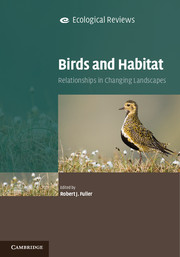Book contents
- Frontmatter
- Contents
- List of Contributors
- Preface
- Part I The complexity of patterns and processes
- Part II Case studies of habitat use and selection
- Chapter Eight Spatial variation and habitat relationships in moorland bird assemblages: a British perspective
- Chapter Nine Arctic-alpine mountain birds in northern Europe: contrasts between specialists and generalists
- Chapter Ten Bird–habitat relationships in reedswamps and fens
- Chapter Eleven Breeding waders on wet grassland: factors influencing habitat suitability
- Chapter Twelve Processes influencing bird use of estuarine mudflats and saltmarshes in western Europe
- Chapter Thirteen Avian habitat use on the non-estuarine intertidal coast
- Chapter Fourteen Temperate western European woodland as a dynamic environment for birds: a resource-based view
- Part III Wider perspectives
- Species index
- Subject index
- References
Chapter Eleven - Breeding waders on wet grassland: factors influencing habitat suitability
Published online by Cambridge University Press: 05 December 2012
- Frontmatter
- Contents
- List of Contributors
- Preface
- Part I The complexity of patterns and processes
- Part II Case studies of habitat use and selection
- Chapter Eight Spatial variation and habitat relationships in moorland bird assemblages: a British perspective
- Chapter Nine Arctic-alpine mountain birds in northern Europe: contrasts between specialists and generalists
- Chapter Ten Bird–habitat relationships in reedswamps and fens
- Chapter Eleven Breeding waders on wet grassland: factors influencing habitat suitability
- Chapter Twelve Processes influencing bird use of estuarine mudflats and saltmarshes in western Europe
- Chapter Thirteen Avian habitat use on the non-estuarine intertidal coast
- Chapter Fourteen Temperate western European woodland as a dynamic environment for birds: a resource-based view
- Part III Wider perspectives
- Species index
- Subject index
- References
Summary
In this chapter, we describe habitat requirements of breeding waders (also known as meadow birds) on lowland grasslands in western and north western Europe. Eight wader species breed on lowland wet grassland in this region: oystercatcher Haematopus ostralegus, lapwing Vanellus vanellus, dunlin Calidris alpina, ruff Philomachus pugnax, snipe Gallinago gallinago, black-tailed godwit Limosa l. limosa, curlew Numenius arquata and redshank Tringa totanus. Populations of most of these species have declined on lowland wet grassland in recent decades (Stanbury et al., 2000; Henderson et al., 2002; BirdLife International, 2004; Thorup, 2004; Wilson et al., 2005). The habitat requirements of several of these species have been well studied, mainly with the aim of diagnosing causes of their population declines and testing solutions for improving habitat quality. We describe the results of this research, and how they have been used to inform land management. In contrast, the habitat requirements of most other bird species on lowland wet grassland have received little attention, with the exception of those of wildfowl. For a general account of the wider breeding and wintering bird assemblages of wet grassland see Fuller (1982).
Two aspects of habitat quality are particularly significant to breeding waders. The first is the importance of agricultural management in affecting habitat suitability. The second is that breeding productivity can be strongly influenced by land management carried out after birds have settled to nest. Hence, there is the potential for birds to settle in areas that are initially of high quality, but which turn out to be of low quality because of subsequent management decisions, i.e. an ecological trap (Chapter 1).
- Type
- Chapter
- Information
- Birds and HabitatRelationships in Changing Landscapes, pp. 278 - 306Publisher: Cambridge University PressPrint publication year: 2012
References
- 5
- Cited by

